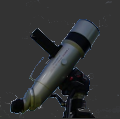Binocular Basics
Topics
1. Aperture, Magnification and Field Size
2. Exit Pupils
3. Coatings
4. Prisms
5. Focusing
1. Aperture, Magnification and Field Size
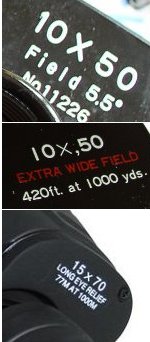
These are the numbers, usually printed on the binocular, that
designate the size of the aperture (in millimetres), the magnification
of the binocular and the field of view. Examples from common small and
medium astronomical binoculars:
Magnification and Aperture
10×50: This binocular has an aperture of 50mm and a
magnification of ×10. Its exit pupil is 50/10 mm = 5mm.
15×70: This binocular has an aperture of 70mm and a
magnification of ×15. Its exit pupil is 70/15 mm = 4.7mm.
Field of View
Field 5.5°: This is the true field of view of the
binocular in degrees.
420ft at 1000yds: This field of view specification (number
of feet at 1000 yds) is common on binoculars for the US market. To
convert to degrees, divide the number of feet by 6000, take the inverse
tangent of the result, and double your answer:
420 ÷ 6000 = 0.07
tan-1 0.07 = 4.0°
2 × 4.0° = 8.0°
77m at 1000m: This field of view specification (number of
metres at 1000 metres) is common on binoculars for the European market.
To convert to degrees, divide the number of metres by 2000, take the
inverse tangent of the result, and double your answer:
77 ÷ 2000 = 0.0385
tan-1 0.0385 = 2.2°
2 × 2.2° = 4.4°
Caveat:
In recent times, some Chinese budget binoculars have been produced with bizarre numbering, such as 60×90, when they are actually something entirely different, e.g 12×60. Other examples I have encountered in fixed magnification binoculars (there are no good zoom binoculars!) are a "20×50" that is a 10×50 and a "30×60" is a 15×22.
2. Exit Pupils
The exit pupil (also known as the eye ring) is the
position of the image, formed by the eyepiece, of the objective lens.
It is the smallest disc through which all the collected light passes
and is therefore the best position for the eye's pupil. Ideally, it
should be no larger than the eye's pupil.
Size
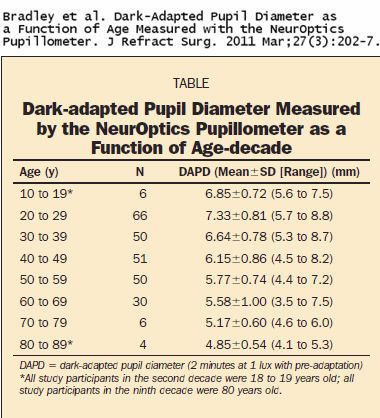
The size of the eye's pupil varies a great deal between
individuals and diminishes with age, as is shown in this table:
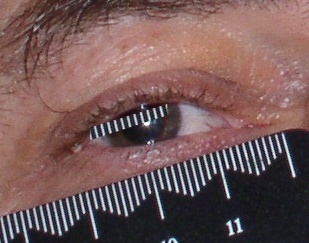
If you are concerned that your eye's pupil may vignette the
binocular image, you should measure your exit pupil. This is most
easily done approximately by standing in front of a mirror at night,
waiting 30 seconds or so for your pupils to dark adapt, hold a ruler
under the eye, in the same vertical plane as your pupil, photograph the
eye in the mirror (use flash, but not anti-red-eye pre-flash), then use
image manipulation software to move a section of the ruler over the
diameter of the pupil.
Ideally, you will then acquire binoculars whose exit pupis are no bigger
than your eye's pupil.
Eye Relief
This is the distance from the eye lens of the eyepiece to the exit pupil. Spectacle wearers require sufficient eye relief to enable them to place the eye at the exit pupil.
3. Coatings
 Binocular coatings are qualitatively described as "coated",
"fully multi-coated", etc. There is no universally agreed meaning to
these designations, but they are commonly held to have the following
meanings:
Binocular coatings are qualitatively described as "coated",
"fully multi-coated", etc. There is no universally agreed meaning to
these designations, but they are commonly held to have the following
meanings:
Coated: At least one glass-to-air surface (usually the
outer surface of the objective) has a single layer of anti-reflective
coating, usually MgF2; other surfaces are uncoated.
Fully Coated: All glass-to-air surfaces of the lenses
(but not the prism hypotenuses) have a layer of anti-reflective coating.
Multi-coated: At least one glass-to-air surface (usually
the outer surface of the objective) has two or more layers of
anti-reflective coating. The other surfaces may be single-layer coated
or not coated at all.
 Fully Multi-coated: All glass-to-air surfaces of the
lenses (but possibly not the prism hypotenuses) have two or more layers
of anti-reflective coating.
Fully Multi-coated: All glass-to-air surfaces of the
lenses (but possibly not the prism hypotenuses) have two or more layers
of anti-reflective coating.
More recently, some binoculars coatings have been described as
"broadband". Again, there is no industry-wide standard—it can mean
anything from 3 layers upward. Some manufacturers are more forthcoming
as to the precise nature of their coatings. For example, Kunming
Optical, the manufacturer of the popular Oberwerk-branded binoculars in
the USA (branded as Strathspey in the UK, Teleskop Service in Germany)
provides the following information about its coatings:
Level I: (Equivalent to Fully Coated) Single layer of MgF2
coating on 16 glass-to-air surfaces: 4 for two objectives, 12 (6 per
side) for the three optical elements in each eyepiece. The prisms are
not coated.
Level II: (Equivalent to a blend of Multi-Coated and
Fully Multi-Coated) Broadband multi-coatings of 5-7 layers on the 4
glass-to-air surfaces of the two objectives, and the 4 surfaces of the
eye lenses of the two eyepieces. Single-layer MgF2 coating
on all other glass-to air surfaces, including the hypotenuses of the
prisms.![]() Level III: Broadband multi-coatings on all the surfaces
except the prism hypotenuses, on which there are single-layer MgF2
coatings.
Level III: Broadband multi-coatings on all the surfaces
except the prism hypotenuses, on which there are single-layer MgF2
coatings.
Level IV: Broadband multi-coatings on all the surfaces
including the prism hypotenuses.
N.B. There is no guarantee that the coatings have been properly applied. If quality control is poor (as it tends to be with budget binoculars), improperly applied multi-coatings could give worse transmission than a properly applied single coating!
4. Prisms
Prism Type: Porro or Roof?
The prisms in binoculars serve primarily to correct the
inverted and laterally reversed image that would otherwise result from
the objective and eyepiece alone. A secondary effect is that they fold
the light path, so that the binocular is shorter than it would
otherwise be, making it easier to handle. For modern binoculars without
angled eyepieces, there are two basic types: the porro prism and the
roof prism.
Porro Prisms. The Porro prism assembly consists of
two isosceles right-angled prisms mounted with their hypotenuses facing
each other but with their long axes exactly perpendicular. Porro prisms
are usually considered to offer the best value for money in
astronomical binoculars; they are certainly less expensive than roof
prism binoculars of equivalent optical quality. The light path in Porro
prisms is like this:

Roof Prisms. The Pechan roof prism (above) is a
combination of a semi penta prism (45° deviation prism) and a Schmidt
roof prism: The combination is a compact combination that results in an
almost "straight through" light path. The consequence is a very compact
binocular. There is, of course, a limit to the aperture of roof prism
binoculars that is imposed by the "straight through" light path
because, the centres of the objectives cannot be separated by more than
the observer's inter-pupillary distance.
Although the roof-prism configuration is physically smaller and thus
uses less material in its construction, it has to be made to a much
higher tolerance (e.g. 2 arcsec for the roof) than is acceptable for
Porro prisms (10 arcmin), i.e. 300 times as precise!
Any thickness or irregularity in the ridge of the roof will result in
visible flares, particularly from bright, high-contrast objects, i.e.
many astronomical targets. Additionally, a result of the wave nature of
light is that interference can occur when a bundle (or "pencil") of
rays is separated and recombined, as happens with a roof prism. The
consequence is a reduction in contrast. This can be reduced by the
application of a "phase coating" to the faces of the roof. Binoculars
with phase coatings usually have "PC" as part of their designation (see
below).
The demand for better quality of the optical elements and their
coatings in roof-prism binoculars means that they will inevitably be
more expensive than Porro prism binoculars of equivalent optical
quality. They do, however, offer three distinct advantages:
- They are more compact. This makes them slightly easier to pack and carry; some people (I am one) find the smaller size easier and more comfortable to hold as a consequence of the different ergonomics.
- They are usually slightly lighter. This makes them easier to carry and generally less tiring to hold.
- They are easier to waterproof as a consequence of the internal focusing. Although we do not normally do astronomy in the rain (the possible exception being the nocturnal equivalent of a "monkeys' wedding"), nitrogen-filled waterproof binoculars are immune to internal condensation in damp/dewy conditions and will not suffer from possible water penetration when used for other purposes such as bird-watching or racing.
It is a matter of personal judgement whether these advantages warrant
the extra expense.
There is a common misconception that roof-prism binoculars are "birding binoculars" and that
Porro-prism binoculars are inherently better for astronomy. Whereas roof-prism binoculars are
advantageous for birding (lighter, easier to waterproof) and Porro-prism binoculars generally
offer equivalent optical quality at a lower price and are not aperture-limited because of the design,
either can be used for either activity, where the one with the
better optical quality will generally perform better.
Prism Glass: BaK4 or BK7?
A consideration is the glass used for the prism. Normal BK7 glass has a lower refractive index than the optically denser BaK4 glass that is used in better binoculars (but see Note 3 below!). A higher refractive index results in a smaller critical angle, 39.6° in BaK4 as compared to 41.2° in BK7), so there is less light likely to be lost because of non-total internal reflection in the prisms:
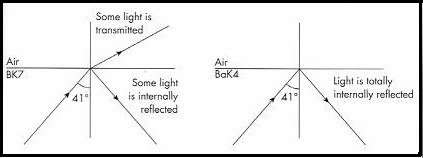
The difference is more noticeable in wide angle binoculars whose objective lenses have a focal ratio of f/5 or less. The non-total internal reflection of the peripheral rays of light cone from the objective results in vignetting of the image. This effect can easily be seen by holding the binocular up to a light sky or other light surface and examining the exit pupil. The exit pupil of a binocular with BaK4 prisms will be perfectly round, whilst that of a binocular with BK7 prisms will have tell-tale blue-grey segments around it:

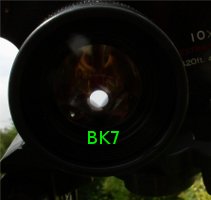
Note 1: The BK7 image was taken from a slight angle in order to show the nature of the vignette segments. Viewed from directly behind the exit pupil, there is a square central region with vignette segments on four sides.
If the segments are black, this is an indication of undersized prisms, a cost-cutting measure in budget binoculars.
Note 2. There is no industry-wide standard for coating names. The designations I have been using above are those from Schott AG, a German manufacturer of optical glass. However, Chinese BaK4 is not the same as Schott BaK4; it's not even Barium Crown glass! It has a refractive index (and, hence, critical angle) that is between those of Schott BK7 and BaK4, and the tolerance for "bubble count" is significantly less stringent. It does have the advantage that it is less dispersive, but this is unlikely to be a critical factor in budget binoculars, where colour dispersion will result from other optical components as well.
Note 3: Whilst the type of prism glass does make a difference, there are much more important considerations for binocular choice, such as crispness of focus, flatness of field, edge distortion, chromatic aberration, build quality, smoothness of focus ... I could go on ... and on. The first binocular I ever used for astronomy, a 1960s or '70s vintage Zeiss 10x50, had BK7 prisms and single-layer coatings — overall it was optically and mechanically superior, and hence better suited to astronomy, than many of today's budget fully multi-coated efforts with BaK4 prisms.
5. Focusing Mechanisms
There are three different types of focusing mechanism commonly found on binoculars:
Centre Focus (Porro Prism)
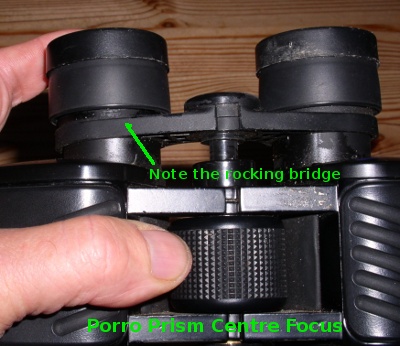
The eyepieces are connected to a threaded rod in the
central hinge. An internally threaded knurled wheel or cylinder causes
the rod to move, thus moving the eyepieces.
The advantage is that the eyepieces can be focused
simultaneously, which is a consideration for general terrestrial use,
but not for astronomy, where refocusing is rarely necessary during an observing session. The disadvantages are that there is almost
always some rocking of the bridge, which leads to difficulty in
achieving and maintaining focus, the focusing system is difficult to
seal, so dirt can enter, and the optical tubes are extremely difficult
to water-proof, resulting in increased likelihood of internal
condensation.
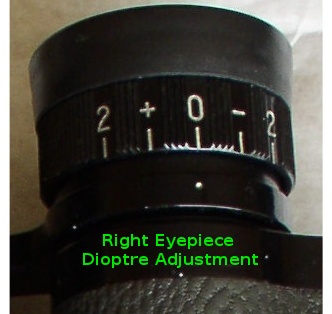
The right hand eyepiece is
usually independently focusable in order that differences in focus of
the observer's eyes can be accommodated; this facility is often called
a 'dioptre adjustment'.
Centre Focus (Roof Prism)
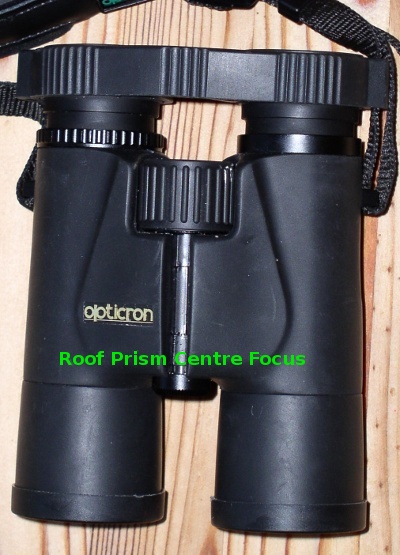
Like the Porro prism centre focus system, there is an
external focus wheel and an independent helical focuser (dioptre
adjustment) for the right eyepiece; the similarity ends there. The
mechanism is internal and focusing is achieved by changing the position
of a focusing lens between the objective lens and the prism assembly.
It has the dual advantages of permitting simultaneous focusing of both
eyepieces and allowing relatively simple dust- and water-proofing. The
disadvantage is that there is an extra optical element that must be
accurately made, which absorbs a tiny amount of light, and whose
movement during focusing alters the field of view slightly.
Independent Focus

The eyepieces each have a helical focuser. This is much
more robust than a centre focus system and is easier to make dirt-and
water-proof. The best quality astronomical (and marine and military)
binoculars have independent focusing. The disadvantage is that the
eyepieces cannot be focused simultaneously, but this is not an issue
for astronomical observation, where refocusing is not normally
necessary once good focus has been attained.

